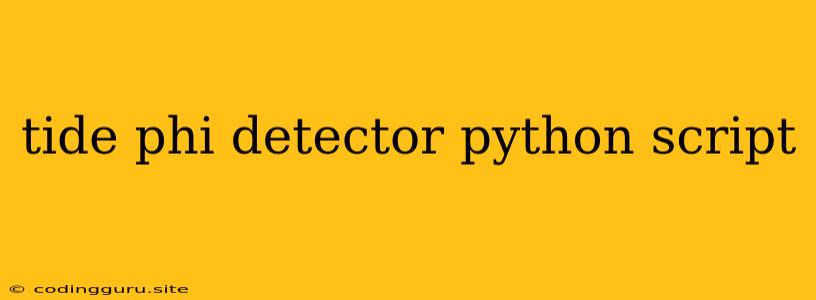Detecting Tides with Python: A Beginner's Guide
The tides are a fascinating natural phenomenon, constantly shaping our coastlines and influencing marine life. For many applications, such as navigation, fishing, or even scientific research, understanding the ebb and flow of the tides is crucial. This is where Python scripting can come in handy.
Python, with its versatility and extensive libraries, offers a powerful tool for analyzing tidal data and predicting tide patterns. In this article, we'll explore how you can use Python to create a basic tide predictor, starting with gathering data and culminating in a simple prediction script.
1. The Data: Where Do We Get It?
The first step is to acquire accurate tidal data. Fortunately, various sources readily provide this information:
- National Oceanic and Atmospheric Administration (NOAA): NOAA offers a wealth of tidal data through its Tides & Currents website. They provide real-time data as well as historical records for various locations.
- Third-party API services: Several companies specialize in providing APIs for accessing tidal data. These APIs allow you to integrate tidal information directly into your Python applications.
- Open-source datasets: You can find publicly available datasets containing tidal information on platforms like Kaggle.
2. Python Libraries for Tidal Analysis
Once you have the data, you need the right tools to process it. Python libraries specifically designed for time series analysis and data visualization come in handy:
- Pandas: Pandas is a fundamental library in Python for data manipulation and analysis. It provides data structures like DataFrames, which are ideal for storing and organizing tidal data.
- NumPy: NumPy is a powerful library for numerical computation in Python. You'll use it to perform mathematical operations on your tidal data, like calculating trends and averages.
- Matplotlib: Matplotlib is the go-to library for generating static, interactive, and animated visualizations in Python. You can use it to plot tide charts and gain insights from your data.
3. A Simple Python Script to Predict Tides
Let's outline a basic Python script to predict tide levels:
import pandas as pd
import numpy as np
import matplotlib.pyplot as plt
# Load your tidal data into a Pandas DataFrame
data = pd.read_csv('tidal_data.csv', index_col='Date')
# Extract the relevant columns for tide prediction (e.g., time, height)
time = data.index
height = data['Height']
# Use a simple linear regression model to fit a trend line to the data
from sklearn.linear_model import LinearRegression
model = LinearRegression()
model.fit(np.array(time).reshape(-1, 1), height)
# Predict future tide levels
future_time = pd.date_range(start='2024-01-01', end='2024-01-10', freq='H')
future_predictions = model.predict(np.array(future_time).reshape(-1, 1))
# Plot the results
plt.plot(time, height, label='Actual Tides')
plt.plot(future_time, future_predictions, label='Predictions')
plt.xlabel('Date')
plt.ylabel('Tide Level')
plt.legend()
plt.show()
This script demonstrates a basic prediction using linear regression. You can further refine your model using more complex algorithms like harmonic analysis, which better captures the cyclical nature of tides.
4. Considerations for a More Accurate Model
Remember, the accuracy of your tide prediction depends on several factors:
- Data quality: The quality of your data is crucial. Ensure your data is accurate and covers a sufficient time period to capture all relevant tidal patterns.
- Location: Tidal patterns vary significantly based on geographic location. Use data specific to your target location.
- Model selection: The choice of prediction model affects the accuracy. Consider exploring more sophisticated models for higher accuracy.
5. Further Exploration
The example presented here is a basic introduction to tide prediction with Python. There are numerous other functionalities you can explore:
- Harmonic analysis: Harmonic analysis involves decomposing tidal signals into constituent waves, providing more accurate predictions.
- Tide forecasting APIs: Integrate your application with tide forecasting APIs for real-time tidal information.
- Visualization enhancements: Create interactive visualizations that allow users to explore tidal patterns and make informed decisions.
Conclusion
This exploration provides a solid foundation for harnessing the power of Python to analyze and predict tides. By understanding the basic principles and leveraging available tools, you can develop applications that benefit from accurate tidal information. Remember, accurate tide prediction is essential for various fields, and with Python, you have the ability to create custom solutions that meet your specific requirements.
